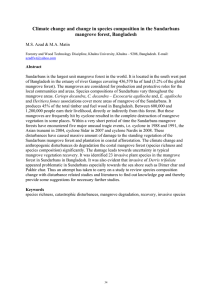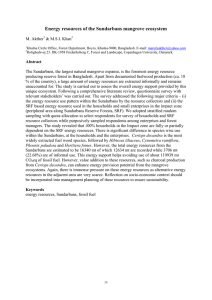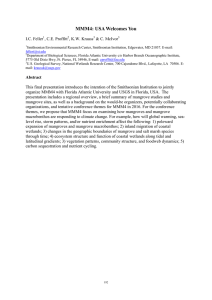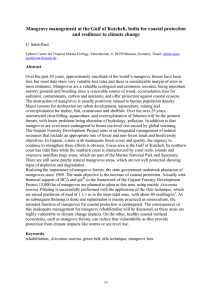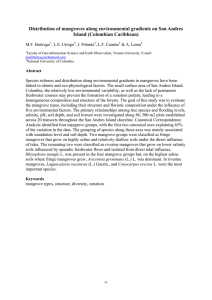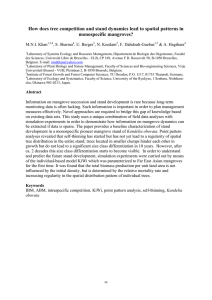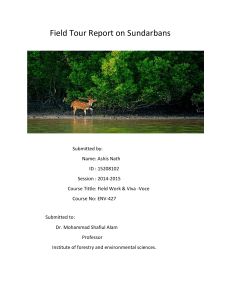Eco-floristic survey of mangrove population of Sundarbans, West Bengal,
advertisement
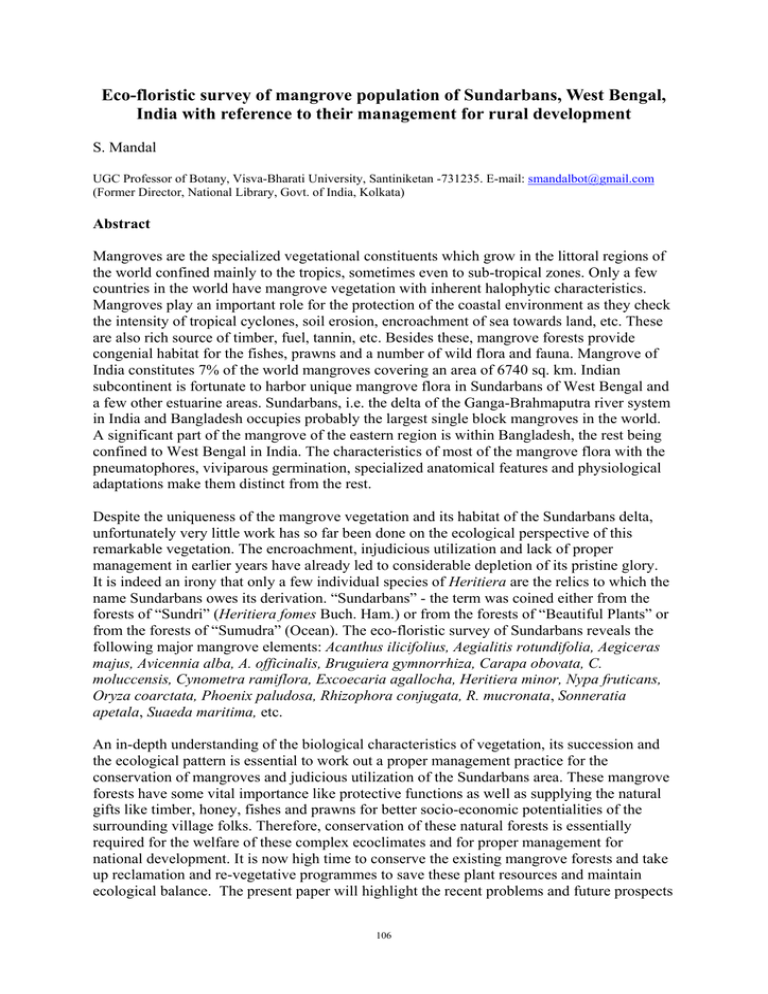
Eco-floristic survey of mangrove population of Sundarbans, West Bengal, India with reference to their management for rural development S. Mandal UGC Professor of Botany, Visva-Bharati University, Santiniketan -731235. E-mail: smandalbot@gmail.com (Former Director, National Library, Govt. of India, Kolkata) Abstract Mangroves are the specialized vegetational constituents which grow in the littoral regions of the world confined mainly to the tropics, sometimes even to sub-tropical zones. Only a few countries in the world have mangrove vegetation with inherent halophytic characteristics. Mangroves play an important role for the protection of the coastal environment as they check the intensity of tropical cyclones, soil erosion, encroachment of sea towards land, etc. These are also rich source of timber, fuel, tannin, etc. Besides these, mangrove forests provide congenial habitat for the fishes, prawns and a number of wild flora and fauna. Mangrove of India constitutes 7% of the world mangroves covering an area of 6740 sq. km. Indian subcontinent is fortunate to harbor unique mangrove flora in Sundarbans of West Bengal and a few other estuarine areas. Sundarbans, i.e. the delta of the Ganga-Brahmaputra river system in India and Bangladesh occupies probably the largest single block mangroves in the world. A significant part of the mangrove of the eastern region is within Bangladesh, the rest being confined to West Bengal in India. The characteristics of most of the mangrove flora with the pneumatophores, viviparous germination, specialized anatomical features and physiological adaptations make them distinct from the rest. Despite the uniqueness of the mangrove vegetation and its habitat of the Sundarbans delta, unfortunately very little work has so far been done on the ecological perspective of this remarkable vegetation. The encroachment, injudicious utilization and lack of proper management in earlier years have already led to considerable depletion of its pristine glory. It is indeed an irony that only a few individual species of Heritiera are the relics to which the name Sundarbans owes its derivation. “Sundarbans” - the term was coined either from the forests of “Sundri” (Heritiera fomes Buch. Ham.) or from the forests of “Beautiful Plants” or from the forests of “Sumudra” (Ocean). The eco-floristic survey of Sundarbans reveals the following major mangrove elements: Acanthus ilicifolius, Aegialitis rotundifolia, Aegiceras majus, Avicennia alba, A. officinalis, Bruguiera gymnorrhiza, Carapa obovata, C. moluccensis, Cynometra ramiflora, Excoecaria agallocha, Heritiera minor, Nypa fruticans, Oryza coarctata, Phoenix paludosa, Rhizophora conjugata, R. mucronata, Sonneratia apetala, Suaeda maritima, etc. An in-depth understanding of the biological characteristics of vegetation, its succession and the ecological pattern is essential to work out a proper management practice for the conservation of mangroves and judicious utilization of the Sundarbans area. These mangrove forests have some vital importance like protective functions as well as supplying the natural gifts like timber, honey, fishes and prawns for better socio-economic potentialities of the surrounding village folks. Therefore, conservation of these natural forests is essentially required for the welfare of these complex ecoclimates and for proper management for national development. It is now high time to conserve the existing mangrove forests and take up reclamation and re-vegetative programmes to save these plant resources and maintain ecological balance. The present paper will highlight the recent problems and future prospects 106 of plant resources in the context of environmental degradation and global warming for biodiversity conservation. Keywords Sundarbans, encroachment, injudicious utilization, eco-floristic survey, management 107
